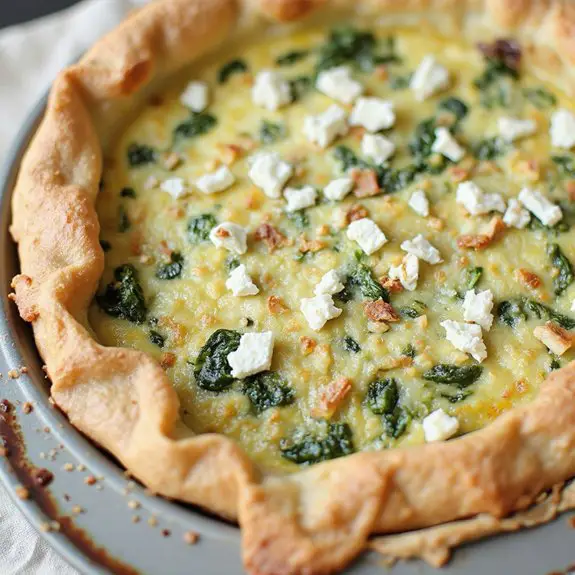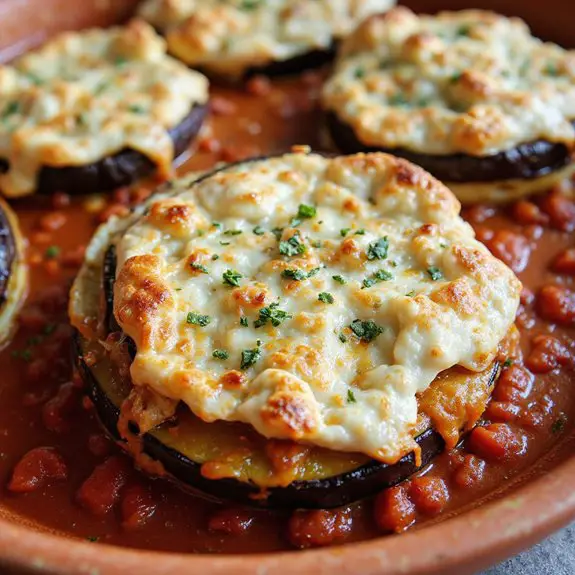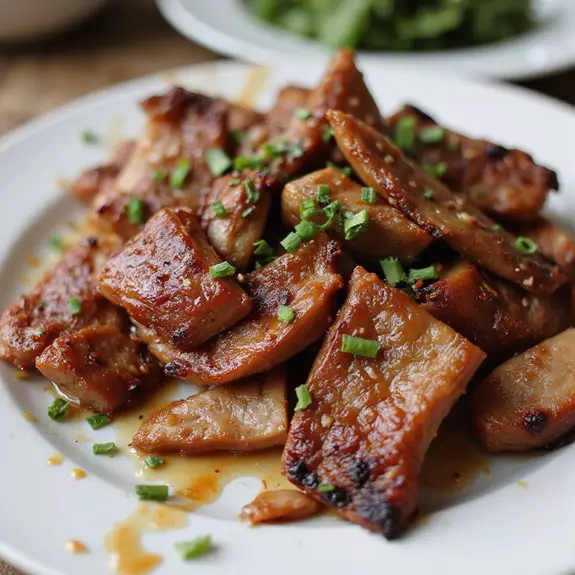Picture the satisfying crunch as you bite into a perfectly golden Japanese pork cutlet, its savory aroma filling the kitchen.
This comforting dish is surprisingly easy to prepare, making it a beloved favorite for both weekday dinners and special occasions.
As the ingredients transform, the pork becomes juicy and flavorful, enhanced by a delightful sauce.
Let’s bring this dish to life and enjoy a taste of Japan at home.
Kitchen Tools Required
- 1 frying pan
- 1 mixing bowl
- 1 whisk
- 1 plate
- 1 knife
- 1 cutting board
- 1 paper towel
Ingredients
- 4 boneless pork chops
- 1 cup all-purpose flour
- 2 large eggs
- 1 cup panko breadcrumbs
- 1/2 teaspoon salt
- 1/4 teaspoon black pepper
- 1/2 cup vegetable oil
- 1 tablespoon soy sauce
- 1 tablespoon mirin
- 1 tablespoon sake
- 1 tablespoon sugar
- 1/2 cup cabbage, thinly sliced
- 1 lemon, cut into wedges
Cook & Prep Time
To efficiently manage your time while preparing and cooking the Japanese Pork Cutlet, follow this timeline:
Preparation Phase:
- Reading the Recipe (5 minutes):
- Start by reading through the entire recipe to familiarize yourself with the steps and ingredients needed.
- Prepping Ingredients (10 minutes):
- Gather and measure all ingredients: pork chops, flour, eggs, panko breadcrumbs, salt, pepper, vegetable oil, soy sauce, mirin, sake, sugar, cabbage, and lemon.
- Prepare your work area with necessary tools: cutting board, knife, mixing bowl, whisk, and plates.
- Preparing Pork Chops (5 minutes):
- Make small cuts along the edges of the pork chops to prevent curling.
- Season the pork chops with salt and black pepper on both sides.
- Coating Pork Chops (5 minutes):
- Coat each pork chop in flour, followed by the egg mixture, and finally the panko breadcrumbs.
Cooking Phase:
5. Heating Oil and Frying (20 minutes):
- Heat the vegetable oil in the frying pan over medium heat.
- Fry each pork chop for 4-5 minutes on each side until golden brown and cooked through.
6. Preparing Sauce and Draining Pork (5 minutes):
- While frying, mix soy sauce, mirin, sake, and sugar to create the sauce.
- Transfer cooked pork chops to a paper towel-lined plate to drain excess oil.
7. Resting and Serving (5 minutes):
- Let the pork chops rest for 5 minutes.
- Slice the pork cutlets and serve with thinly sliced cabbage and lemon wedges, drizzling with the sauce as desired.
Note: Adjust the timeline if you find yourself needing a bit more or less time for certain tasks.
Recipe Instructions
Place pork chops on a cutting board and use a knife to make small cuts along the edges to prevent curling.
Lightly season the pork chops with salt and black pepper on both sides.
Place flour on a plate and coat each pork chop with flour, shaking off any excess.
In a mixing bowl, whisk together eggs and lightly coat each pork chop in the egg mixture.
Place panko breadcrumbs on a plate and coat each pork chop thoroughly.
Heat vegetable oil in a frying pan over medium heat.
Add pork chops to the pan and cook for 4-5 minutes on each side until golden brown and cooked through.
Mix soy sauce, mirin, sake, and sugar in a small bowl to create the sauce.
Transfer cooked pork chops to a paper towel-lined plate to drain excess oil.
Let the pork chops rest for 5 minutes before slicing.
Serve the sliced pork cutlets with thinly sliced cabbage and lemon wedges, drizzling with the sauce as desired.
Serving Tips
- Steamed Rice: A classic accompaniment that balances the savory flavors of the pork cutlet.
- Miso Soup: A warm and comforting side that complements the crispy texture of the cutlet.
- Pickled Vegetables: Adds a zesty tang to contrast with the richness of the pork.
- Green Salad: Offers a fresh and light counterpoint to the hearty main dish.
- Japanese Curry Sauce: Pour over the pork cutlet for a rich and flavorful variation.
Storage
To store leftover Japanese pork cutlets, refrigerate in an airtight container for up to three days.
Reheat gently in an oven to maintain crispiness.
Avoid microwaving to prevent sogginess.
Freezing
To freeze Japanese pork cutlet, first let them cool completely.
Then wrap individually in plastic wrap and foil.
Store in an airtight container or freezer bag for up to three months.
Reheating
To reheat Japanese pork cutlets, use an oven or toaster oven at 350°F for 10-15 minutes.
This method maintains crispiness without drying out the meat.
Avoid microwaving.
Final Thoughts
Japanese Pork Cutlet, also known as Tonkatsu, is a delicious and satisfying dish that combines the savory flavors of crispy pork with a tangy sauce.
The preparation is straightforward and requires a few simple steps, ensuring that even beginners can enjoy making this delightful meal.
By following the cooking times and allowing the cutlets to rest, you enhance the juiciness and overall taste of the pork.
Pairing the cutlet with thinly sliced cabbage and lemon wedges adds a revitalizing contrast to the richness of the dish.
Enjoy this classic Japanese cuisine at home and savor the harmonious blend of flavors.
Frequently Asked Questions
Can I Use Chicken Instead of Pork for This Recipe?
You can substitute chicken for pork. Use boneless chicken breasts or thighs. Adjust cooking time to guarantee chicken reaches an internal temperature of 165°F. Follow the same steps for coating and frying to achieve a similar crispy texture.
What Can I Substitute for Mirin if Unavailable?
You can substitute mirin with a mixture of rice vinegar and sugar. Use 1 tablespoon rice vinegar mixed with 1 teaspoon sugar for each tablespoon of mirin required. This maintains the sweet, tangy balance in your dish.
How Can I Make This Dish Gluten-Free?
To make this dish gluten-free, replace all-purpose flour with gluten-free flour, and use gluten-free panko breadcrumbs. Ascertain your soy sauce is labeled gluten-free. Double-check all ingredients for gluten-free certification to avoid cross-contamination.
Is There a Recommended Side Dish to Accompany the Pork Cutlet?
You should serve the pork cutlet with steamed rice and miso soup for a traditional touch. Include pickled vegetables, like daikon or cucumber, for acidity and balance. These sides complement the cutlet’s flavors, enhancing your dining experience.
Can I Use an Air Fryer Instead of Pan-Frying?
Yes, you can use an air fryer. Preheat it to 375°F. Lightly spray pork cutlets with oil. Cook for 10-12 minutes, flipping halfway. Make certain they reach an internal temperature of 145°F for safety and ideal texture.

Japanese Pork Cutlet
Equipment
- 1 Frying pan
- 1 Mixing bowl
- 1 Whisk
- 1 plate
- 1 Knife
- 1 Cutting board
- 1 paper towel
Ingredients
- 4 boneless pork chops
- 1 cup all-purpose flour
- 2 large eggs
- 1 cup panko breadcrumbs
- 1/2 teaspoon salt
- 1/4 teaspoon black pepper
- 1/2 cup vegetable oil
- 1 tablespoon soy sauce
- 1 tablespoon mirin
- 1 tablespoon sake
- 1 tablespoon sugar
- 1/2 cup cabbage thinly sliced
- 1 lemon cut into wedges
Instructions
- Place pork chops on a cutting board and use a knife to make small cuts along the edges to prevent curling.
- Lightly season the pork chops with salt and black pepper on both sides.
- Place flour on a plate and coat each pork chop with flour, shaking off any excess.
- In a mixing bowl, whisk together eggs and lightly coat each pork chop in the egg mixture.
- Place panko breadcrumbs on a plate and coat each pork chop thoroughly.
- Heat vegetable oil in a frying pan over medium heat.
- Add pork chops to the pan and cook for 4-5 minutes on each side until golden brown and cooked through.
- Mix soy sauce, mirin, sake, and sugar in a small bowl to create the sauce.
- Transfer cooked pork chops to a paper towel-lined plate to drain excess oil.
- Let the pork chops rest for 5 minutes before slicing.
- Serve the sliced pork cutlets with thinly sliced cabbage and lemon wedges, drizzling with the sauce as desired.





